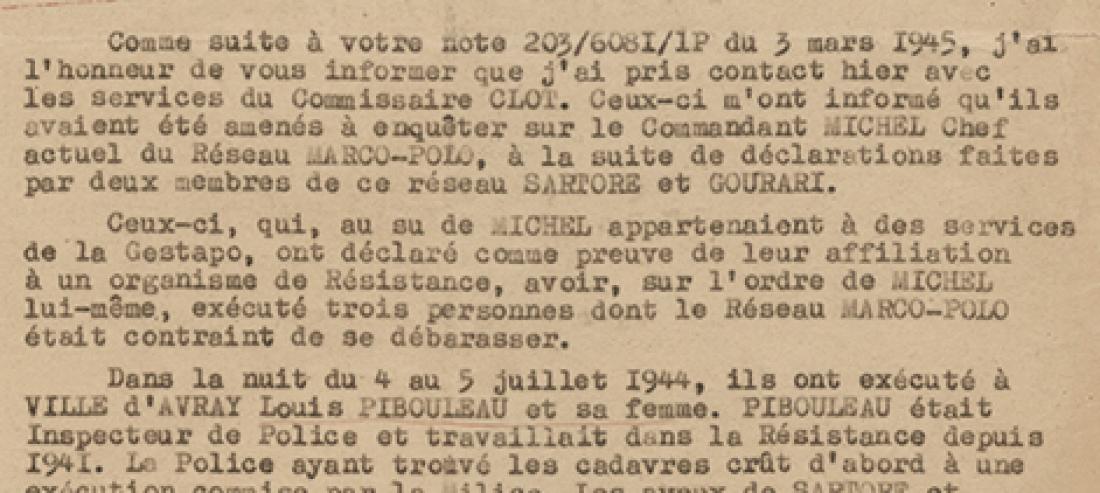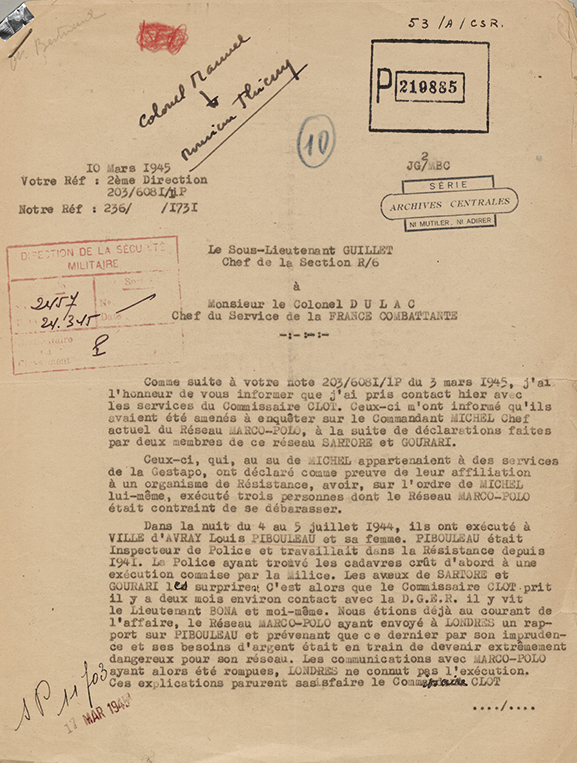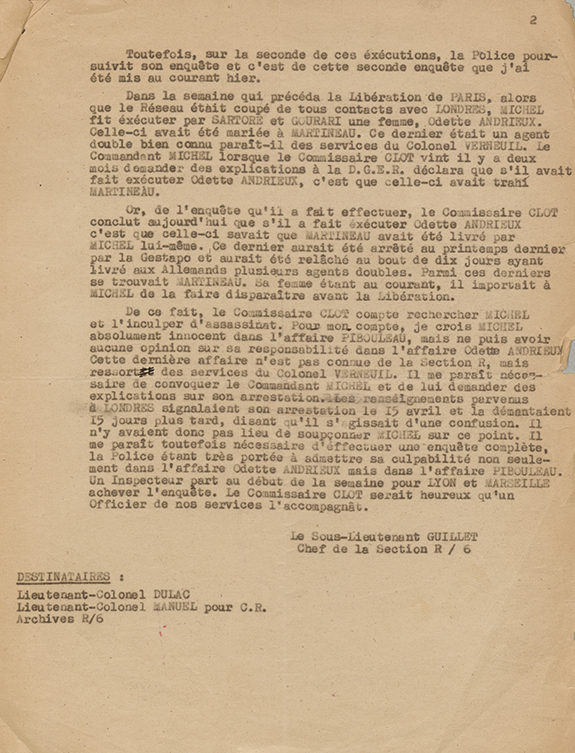Un grand nombre d’exécutions mystérieuses

The deaths of three members of a resistance network in July-August 1944 intrigued the police. The investigation, conducted a few months later by agents of Commissioner Clot's ”special section”, revealed the strange role played by the thugs of the ”Gestapo of Rue Lauriston” and certain agents of the ”Marco Polo” network.
On 16 November 1944, Sartore, known as ”Jean the Bald” (see slideshow), and Gourari, known as ”Robert the Pale”, two members of the Bonny-Lafont group, the notorious ”French Gestapo” of Rue Lauriston (see A cart is ready), were arrested in Seine-et-Oise. Crooks who already had long police records and multiple convictions before the war, and members of the Chamberlin (alias ”Lafont”) gang from 1941, the two men, who belonged to the Rue Lauriston team of ”killers”, were protected by the Germans and ”untouchable” for the French police. Wanted following the Liberation for their part in many operations against the Resistance, they were handed over to the Special Section of the Prefecture of Police in Quai de Gesvres, which was responsible for finding the most dangerous collaborators.
Crooks… Or late converts to the Resistance?
The two men showed Commissioner Clot, who was interrogating them, documents dating from 1 July 1944 that certified their membership of the Marco Polo network. These declarations were signed by ”Captain Michel” (Michel Hardiviller), the network's leader in the northern zone, who would become the overall head of Marco Polo in September 1944 following the arrest and death of ”Commander Octave” (René Pellet) and then an officer of the Direction générale des études et recherches (DGER, Directorate General of Studies and Research). They claimed that they had executed three members of the network on his orders: a couple called Pibouleau in early July 1944 in Ville d'Avray, and Odette Andrieux, whose married name was Martineau, in mid-August at 22 Rue Laugier in Paris.
The investigation revealed aspects that had been hidden from view for a long time, including confirmation that many networks had been penetrated by double agents playing a shady, complex game (the ”Gestapos” of Rue Lauriston, Rue de la Pompe, Avenue Foch etc.); the reality of betrayal, the resulting psychosis in the microcosm of the resistance, leading in turn to executions sometimes decided very lightly; the collusion between certain resistance agents and criminals; the importance of money, sex, jealousy, ambition and personal rivalries in the motivations of resistance members who appear in their naked humanity: men and women with all their faults, pettiness, weakness and baseness.
Executions or murders?
These three executions, which the police treated as murders since their motivations seemed to be based solely on excuses and slanderous rumours, were only discovered by the DGER in March 1945. They appeared all the more ”irregular” in that the Bureau central de renseignements et d'action (BCRA, Central Bureau of Intelligence and Operations) was apparently quite unaware of them.
The investigations conducted in 1945 and 1948 by the Paris criminal police revealed the Louis and Juliette Pibouleau were executed for the potential - through imaginary - danger they were thought to represent (see slideshow). ”Captain Michel” gave the order to execute the couple. On the pretence that they were to evaluate a site for the installation of a transmitter, Louis and Juliette Pibouleau were sent to Paris, received by a team of killers from Rue Lauriston who had become the Marco Polo network's ”protection-repression team”, and murdered in Ville d'Avray on the night of 4 to 5 July. The crime was imputed to the Milice.
The case was a tragic paradox: a couple of blameless resistance agents - and in the case of Louis Pibouleau, a former Marseille police inspector, a resister from the early days (1941) - struck down on the orders of a network leader by the killers of Rue Lauriston, taking on the mantle of resistance members for the occasion. To justify the crime, slanderous accusations were spread about the victims, accusations that were even included in a request for instructions sent to London - a month after the double murder.
The death of Odette Andrieux also raises many questions. She was killed by Sartore on the orders of ”Michel” on the pretext that she had informed on her husband, Lieutenant Martineau (”Prudhomme”).
Martineau, an officer in the 2nd bureau of the armistice army, who had been arrested in November 1941 and condemned to death by the Germans but escaped under suspicious circumstances, had become a double agent, informing the German intelligence service under the pseudonym of ”Gaston” while also working for the Allied and American intelligence services in Berne and the Marco Polo network, providing them with information obtained from the Germans. When the Germans discovered his double-dealing, he was arrested again on 6 August 1943 at the Gare d'Austerlitz and deported, along with fourteen members of his ”personal network”.
It is hard to know the actual role played by his wife in these arrests, but as the Special Section's investigation note no. 1305 of 12 April 1945 says, the ”execution”, coming a year after the arrest of which she was accused (and four days before the liberation of Paris), appeared all the more suspect in that ”at the time there was nothing to suggest a betrayal by Odette Andrieux”.
These cases illustrate the complexity and the grey areas of the clandestine struggle, but also the human issues it underlies, which explain the lies, half-truths and elisions. All arrests and executions were stained with suspicion, and were subject to investigations and research after the Liberation.
The opening and analysis of the BCRA and DGER archives and those of the Direction de la surveillance du territoire (DST, Directorate of Territorial Surveillance) will enable significant progress. However, these archives will need to be compared systematically with others, such as the police files in this case, and cannot be exempted from an essential critical approach.
Jean-Marc Berlière
Professor of contemporary history at the University of Burgundy,
researcher at CESDIP (CNRS/Ministry of Justice)
FOR MORE INFORMATION
The letter reproduced here is taken from the individual file of Michel Hardiviller, numbered GR 28 P 4 130/22, which can be consulted in the reading room.
The archives of the Paris Prefecture of Police also hold documents on the case (including the identity photograph of Jean Sartore reproduced here).

Rapport du sous-lieutenant Gillet au colonel Dulac au sujet du commandant Michel, chef du réseau Marco-Polo, 10 mars 1945, p. 1.
© SHD


